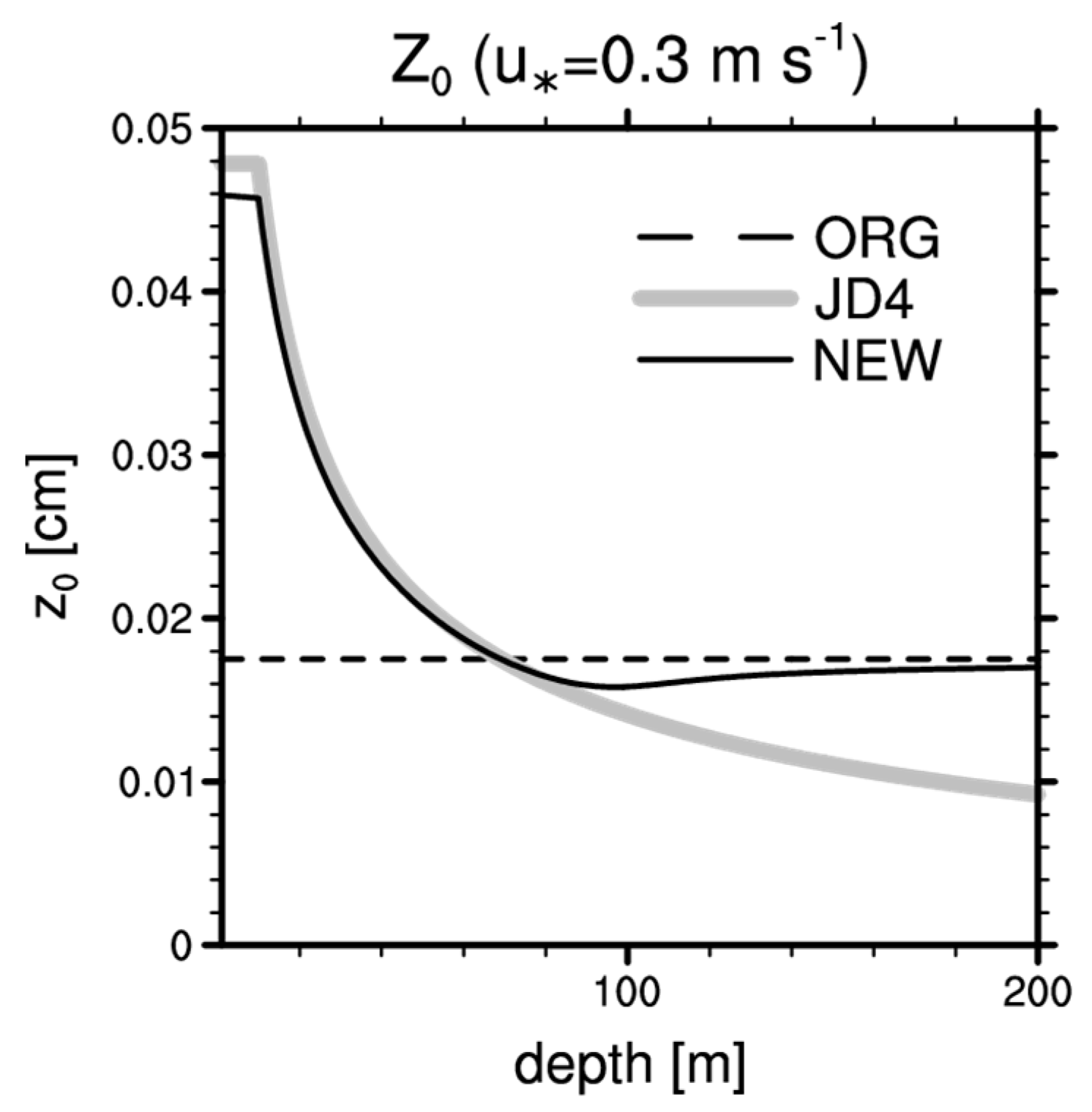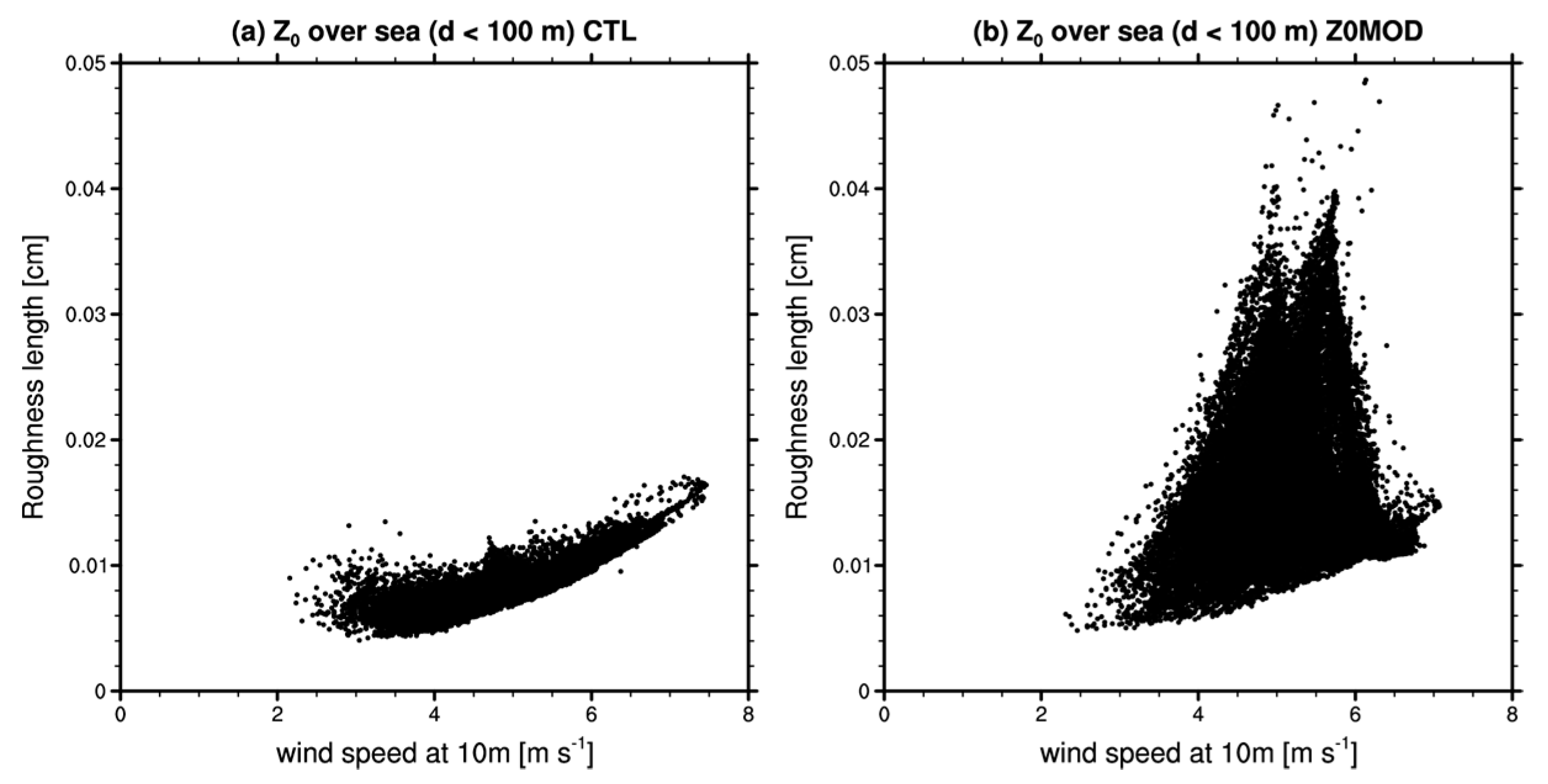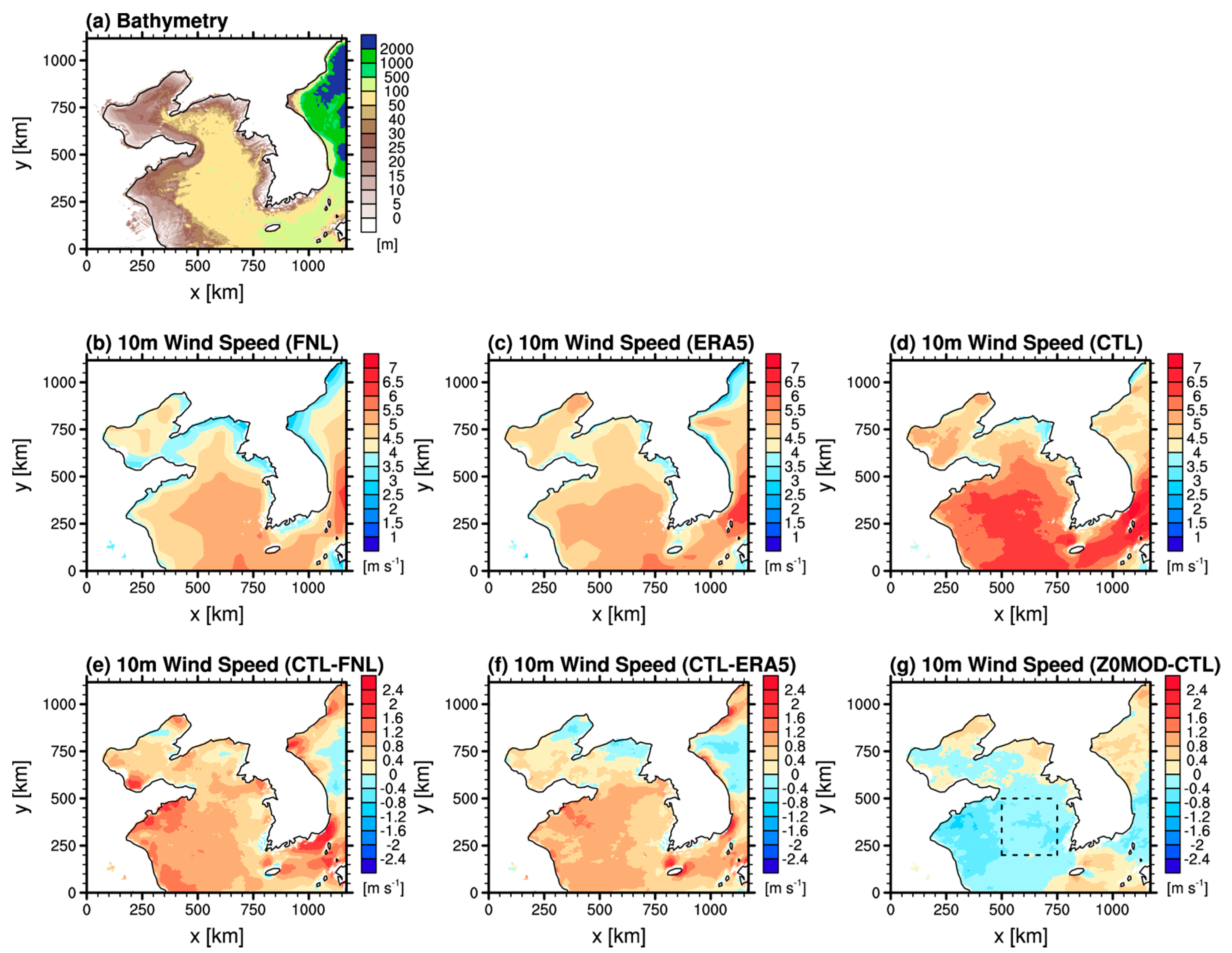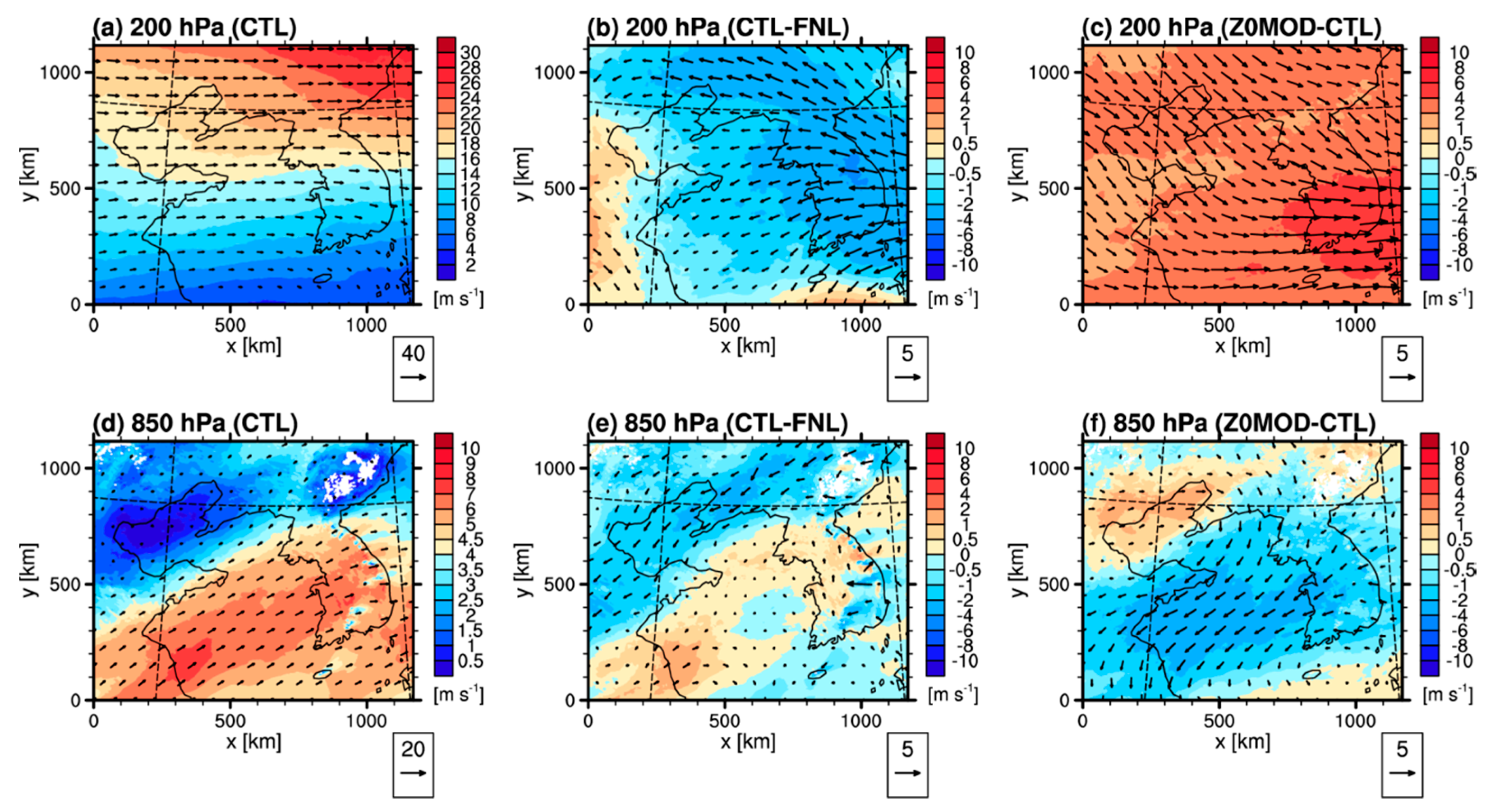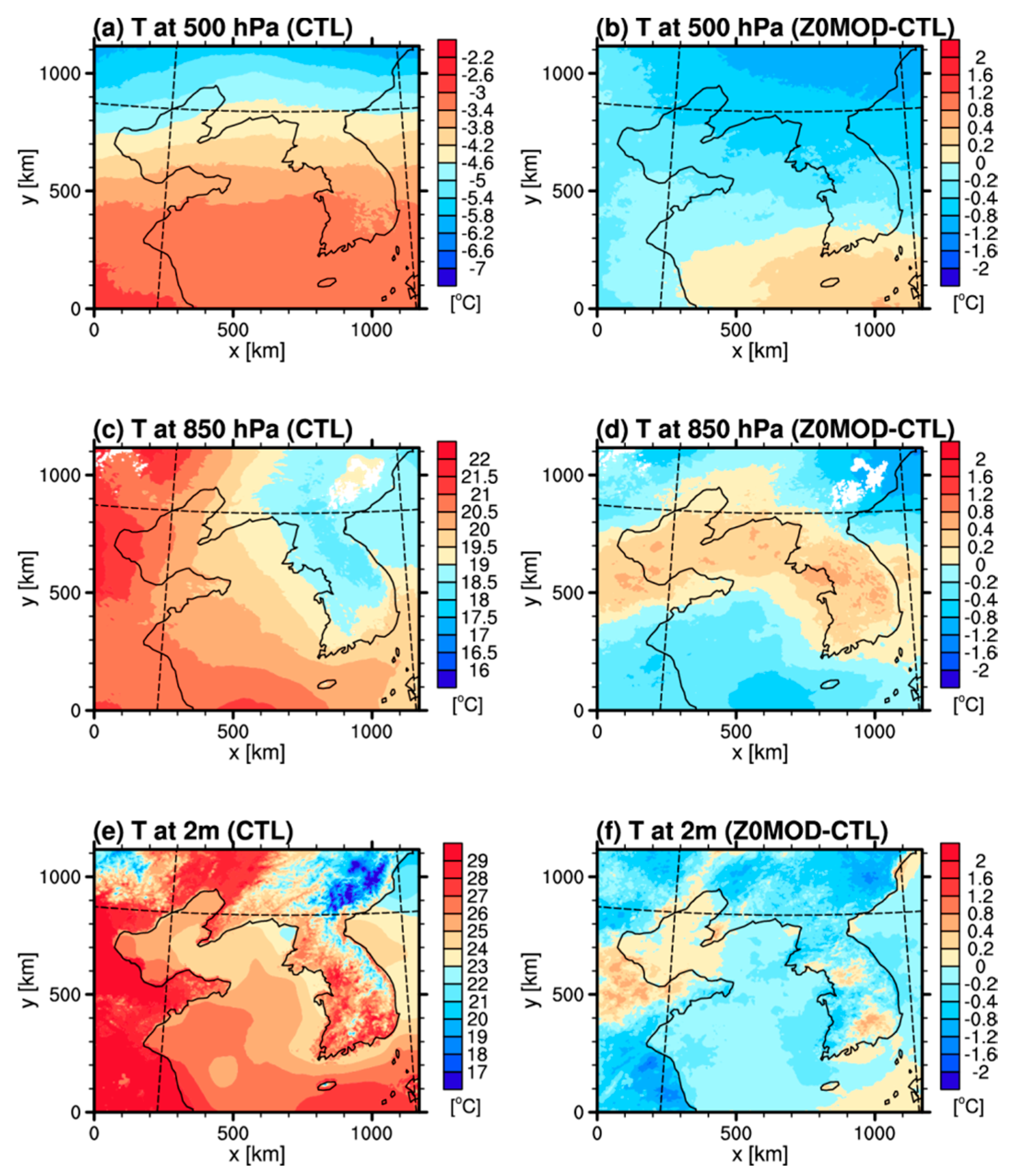1. Introduction
Representation of air-sea interaction is important in numerical weather prediction and climate models, since heat and momentum exchanges between the atmosphere and sea play a critical role in driving atmospheric circulation. Evaporation from the sea is a major source of water vapor in the atmosphere, and the associated latent heat is also important in the energy budget of the atmosphere and sea. Heat and momentum exchanges are affected by the thermodynamic and dynamic states of the sea and atmosphere. In particular, near-surface wind speed has a direct influence on sea-surface wave fields. Furthermore, wind stress is influenced by sea-surface roughness. Oceanographic studies have shown that sea-surface roughness is determined by surface wave characteristics such as development stage, wavelength, and the phase speed of waves (e.g., [
1,
2,
3,
4]).
In numerical weather prediction and climate models, the formula proposed by Charnock (1955) [
5], which represents the sea-surface aerodynamic roughness length as a function of friction velocity, and the revised version of the Charnock formula (e.g., [
2,
6,
7]) have been widely used to calculate sea-surface roughness length. The Charnock formula includes the parameter which was assumed as an empirical constant value (Charnock parameter). Including dependence on the wave characteristics in the Charnock parameter has been suggested. For example, Hsu (1974) [
1] expressed the Charnock parameter as a function of wave steepness, determined by wave height and wavelength of dominant waves. Smith et al. (1992) [
2] and Donelan et al. (1990) [
6] suggested the dependence on wave age represented by phase speed of waves and friction velocity. However, in atmospheric models that require coupling with ocean and wave models in order to predict characteristics of the wave spectrum, the Charnock parameter is often assumed as a constant value representing the average state of sea. Nevertheless, the formula based on Charnock (1955) [
5] represents the relationship between surface wind and sea-surface roughness over the open ocean well, so that atmospheric models simulate near-surface wind over the sea within a reasonable range.
Over shallow waters in coastal regions and the continental shelf, sea-surface waves are affected by the topographical characteristics of the sea floor such as water depth, shape of terrain, and the direction of the coastline relative to the wind. Therefore, sea-surface waves are determined by more complicated mechanisms compared to those occurring in the open ocean [
8]. Observational studies (e.g., [
2,
4]) have shown that sea-surface roughness for a given wind speed is higher over shallow waters than over the open ocean. Recently, Jiménez and Dudhia (2018) [
9] suggested a revised formula to calculate sea-surface roughness length over shallow waters, for use in atmospheric models based on observational data and numerical modeling results.
In this study, sea-surface roughness length over shallow waters is modified based on the formula suggested by Jiménez and Dudhia (2018) [
9], and its impact is examined in a regional climate atmospheric simulation during a boreal summer. In
Section 2, the modification of sea-surface roughness length is explained, and the setup for the numerical experiments is described. The simulation results are examined in
Section 3, and the summary and conclusions are given in
Section 4.
3. Results and Discussion
The distribution of surface roughness lengths over shallow waters with a depth less than 100 m is shown in
Figure 3. In the CTL experiment, surface roughness lengths generally show an increase, with an increase in wind speed except for wind speeds of less than ~3 m s
−1. For wind speed less than ~3 m s
−1, the surface roughness lengths increase with a decrease in wind speed—likely because the contribution of the second term on the right side of Equation (1) increases with a decrease in wind speed. In the Z0MOD experiment, the surface roughness lengths are higher than in the CTL experiment, especially for wind speeds between ~4 m s
−1 and ~6 m s
−1. When the wind speed is less than 3 m s
−1, surface roughness is generally lower than that in the CTL experiment because the term considering the light-wind conditions is absent in the revised formula for shallow waters (Equation (2)). Additionally, maximum wind speed recorded in the Z0MOD experiment is lower than that in the CTL experiment. This implies that, in the Z0MOD experiment, the wind speed at 10 m over shallow waters is reduced due to an increase in surface roughness length.
The bathymetry in D3 indicates that the sea is shallower than 100 m across a large area of the domain except for the eastern part (brown and yellow, sub-figure a in
Figure 4). This is especially evident for the Yellow Sea, which is located between China and the Korean Peninsula. That is why this area was chosen as experimental domain. Over shallow waters, wind speed at 10 m is generally overestimated in the CTL experiment compared to in the FNL data (
Figure 4b,d,e) and the fifth generation of European Center for Medium-range Weather Forecasts (ECMWF) atmospheric re-analyses of global climate (ERA5) data (
Figure 4c,d,f). Near-surface wind speed over the coastal region is often overestimated in atmospheric models that are not coupled with ocean and wave models (e.g., [
19]). Due to an increase in sea-surface roughness length over shallow waters in the Z0MOD experiment, wind speed at 10 m over the Yellow Sea is found to be lower in the Z0MOD experiment than in the CTL experiment (
Figure 4g). This alleviates the wind speed bias, although the reduction is not enough to compensate for the positive bias of wind speed.
Figure 5 shows a comparison with the surface observational dataset including buoy and ship measurements, which is used for the data assimilation system of the Korean Integrated Model [
20,
21]. Since data are sparse and located at different points depending on the measurement time, 10 July 2017—when the number of measurement points is relatively large—was selected for comparison. The wind speed at 10 m in the CTL experiment is generally overestimated over the Yellow Sea compared to that in the observational dataset (
Figure 5a–c), which is consistent with the comparison to the FNL and ERA5 data, and the bias is alleviated in the Z0MOD experiment (
Figure 5d). The wind speed in the southeastern part of the domain is underestimated. Underestimation of wind speed in this part is also found in the comparison to the FNL and ERA5 data for the corresponding date (not shown). In this part, the wind speed at 10 m is enhanced overall by considering water depth in the sea-surface roughness length calculation (
Figure 5d).
Since near-surface wind could be sensitive to the boundary layer and surface layer schemes used, two additional simulations were conducted during 1–10 July 2017 using (i) Mellor–Yamada–Nakanishi–Niino (MYNN) level 2.5 boundary layer scheme [
22], which is a local closure scheme, and (ii) MYNN level 2.5 boundary layer and MYNN surface layer schemes. The overestimation of wind speed at 10 m shown in
Figure 4 is also found in both simulations, although the magnitude of overestimation is different between simulations, and the bias is alleviated by considering water depth in the sea-surface roughness length calculation (not shown). The simulation was also performed during January 2017. An overestimation of wind speed at 10 m is found over the Yellow Sea, but its reduction in the Z0MOD experiment is smaller than in July (not shown). This is likely because the wind speed at 10 m over the Yellow Sea is stronger in January than in July and the enhancement of sea-surface roughness length over shallow waters is less significant for higher wind speeds, as expected in
Figure 3.
The vertical profile of wind speed over the Yellow Sea (dashed box in
Figure 4g) is also calculated (
Figure 6). The wind speed at 10 m is higher in the CTL experiment (blue solid line) than in the FNL (black solid line) and ERA5 data (black dashed line), and this overestimation extends to the mid troposphere (~9 km). In contrast, above ~9 km, the wind speed in the CTL experiment is underestimated compared to that in the FNL and ERA5 data. The difference between the CTL experiment and the FNL/ERA5 data reaches ~3 m s
−1 in the upper levels. This large difference occurs as a result of a shift in the location of a jet and is because the profile is calculated for a small area. In the Z0MOD experiment (red solid line), wind speed at low levels below ~7 km is reduced compared to that in the CTL experiment, in which the wind speed is overestimated, and a decrease in the wind speed is more significant above ~1.5 km than near the surface. As a result, wind speed in the Z0MOD experiment is relatively close to that in the FNL and ERA5 data near the surface, but lower than that in the FNL and ERA5 data between ~1.5 km and ~5.5 km. The effect of considering water depth in sea-surface roughness length calculation is not localized to near-surface levels, but extends into the upper troposphere. Above ~7 km, wind speed increases by considering depth-dependent sea-surface roughness. In particular, the jet in the upper troposphere is largely enhanced in the Z0MOD experiment. Since wind speed at this level is underestimated in the CTL experiment compared to the FNL and ERA5 data, the modified surface roughness in the Z0MOD experiment acts to alleviate this bias. In the present experiments, bias in the CTL experiment is overcompensated in the Z0MOD experiment, and therefore, the Z0MOD experiment overestimates the wind speed in the upper troposphere.
The distributions of upper (200 hPa) and lower (850 hPa) tropospheric horizontal winds are shown in
Figure 7. In the CTL experiment, westerlies at 200 hPa, the speed of which increases with latitude (
Figure 7a), are underestimated compared to those in the FNL data across most of the domain (
Figure 7b). In the Z0MOD experiment, the westerlies are strengthened as shown in
Figure 6, and the northwesterly component is enhanced in the northern part of the domain (
Figure 7c). The difference in 200 hPa wind between the two experiments (Z0MOD–CTL) has opposite sign to that of bias in the CTL experiment against the FNL data (compare
Figure 7b,c). However, the changes occurring due to the modified roughness length overcompensate for the bias and this makes the Z0MOD experiment have the opposite bias to that seen in the CTL experiment. Enhanced westerlies and north-westerlies in the southern and northern part of the domain, respectively, are related to changes in wind in the lower levels. At 850 hPa, the southwesterly flow is dominant (
Figure 7d) and this low-level jet is slightly overestimated over the Yellow Sea (
Figure 7e). The southwesterly flow is weakened in the Z0MOD experiment (
Figure 7f), and this weakens the convergence over the Yellow Sea (not shown). At 200 hPa, changes in flow influenced by modified sea-surface roughness length lead to a decrease in divergence, which could be related to weakened convergence at the lower levels. Over the Yellow Sea, the updraft is also found to be weaker in the Z0MOD experiment than in the CTL experiment (not shown) due to the weakened lower tropospheric convergence and upper tropospheric divergence.
Figure 8 compares the zonal component of wind distribution between the two experiments. As shown in
Figure 7, the modified sea-surface roughness length has led to an increase in zonal wind at 200 hPa across the entire domain, especially in the southern part where the wind speed is relatively low (
Figure 8c). At 850 hPa, the zonal wind is reduced largely over the Yellow Sea where wind speed is relatively high in the CTL experiment while there are some increases in the northern part of the domain (
Figure 8f). Modulated wind in the lower and upper troposphere changes the vertical wind shear. Since zonal wind increases with height (
Figure 8a,d), a positive vertical difference is shown in the CTL experiment (
Figure 8g). This vertical wind shear is relatively weaker compared to that in the FNL data due to overestimated (underestimated) lower (upper) level wind speeds. Weakened wind speed in the lower troposphere and enhanced wind speed in the upper troposphere result in an increase in vertical wind shear in entire domain (
Figure 8i), especially in the southern part of the domain that includes the Yellow Sea. This increase in vertical wind shear of zonal wind contributes to changes in temperature.
Figure 9 shows the effect on temperature. At 500 hPa, the modified sea-surface roughness length decreases temperature overall, except over the southern part of the domain, and the cooling effect is stronger at higher latitudes (
Figure 9b). This enhances the meridional gradient of temperature, which is negative (
Figure 9a). The enhanced negative meridional temperature gradient is related to an increase in the vertical wind shear of zonal wind through the thermal wind relationship. A lag-correlation analysis between the changes in the vertical wind shear of zonal wind and the meridional gradient of 500 hPa temperature indicates that changes in the two variables are highly correlated at lags between 0 and 6 h, when the wind shear change leads to a temperature change (not shown). At 850 hPa, the modified sea-surface roughness length leads to a decrease in temperature over the southern part of the domain, along with an increase in the northern part of the Yellow Sea and the Korean Peninsula (
Figure 9d). The temperature at 850 hPa is found to be affected by near-surface temperature (e.g., temperature at 2 m), which is also decreased over sea overall (
Figure 9f). Additionally, low-level cooling over the Yellow Sea is found to be partly due to colder air advection by the northeasterly flow induced by the modified sea-surface roughness length.
4. Summary and Conclusions
Sea-surface roughness length was modified over shallow waters considering the effect of water depth, and its impact is investigated through a regional climate simulation during a boreal summer. The formula considering water depth suggested by Jiménez and Dudhia (2018) [
9] was used only over shallow waters, and the revised version of the formula proposed by Charnock (1995) [
5] was used for the open ocean. By using a modified formula of sea-surface roughness length that took water depth into consideration, surface roughness length increased over shallow waters, leading to a direct decrease in near-surface wind speeds. As a result, the overestimation of near-surface wind speeds compared to those in the FNL data was alleviated. Lower tropospheric wind speeds were also reduced over shallow waters.
The effects of increased sea-surface roughness over shallow waters were not localized to low-level wind, but extended to the upper tropospheric wind. In the upper troposphere, wind speed was largely increased. The upper tropospheric wind speed was underestimated in the control experiment. Therefore, the enhancement of wind speed by the modified sea-surface roughness length acted to reduce the underestimation of wind speed. In the present simulations, however, the bias was overcompensated and the wind speed in the upper troposphere was overestimated in the experiment with modified sea-surface roughness length. Decreased wind speed in the lower troposphere and increased wind speed in the upper troposphere led to the enhancement of vertical wind shear between the upper and lower troposphere. The vertical difference in zonal wind between 200 hPa and 850 hPa increased, and as a result, the meridional temperature gradient at 500 hPa increased through the thermal–wind relationship. The low tropospheric temperature was also found to be affected by a modulated wind structure.
This study shows that a change in sea-surface roughness length modulates upper-tropospheric wind and temperature, as well as low-level atmospheric features. This modulation is not localized over shallow waters, but is apparent in the entire experimental domain. Additionally, positive changes are shown that help compensate for the bias in the model, although they are excessive in the upper troposphere. This implies that a proper representation of surface properties over the ocean is important in the simulation of upper level atmospheric features as well as of low-level circulation. This study mainly considers the effect of water depth in sea-surface roughness length. There are a number of other factors that could affect sea-surface roughness, including those that represent the state of the ocean, such as wave age, wavelength, and the phase speed of waves. The effects of these factors can be analyzed further by coupling ocean and wave models to atmospheric models.
